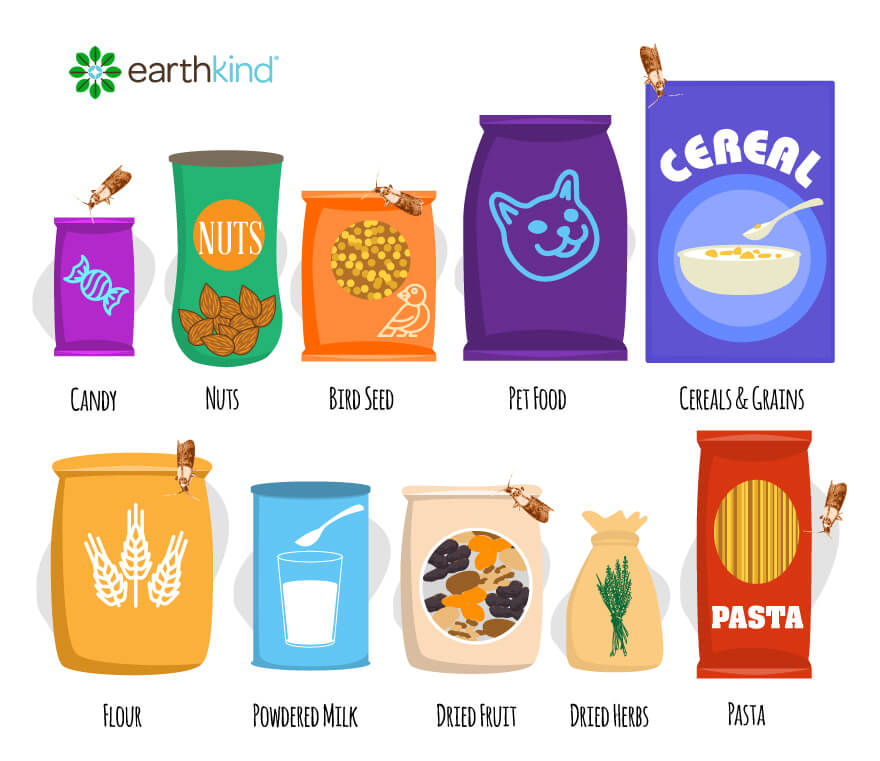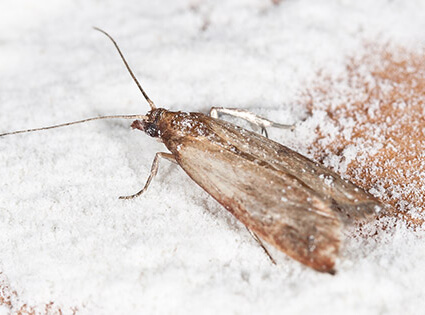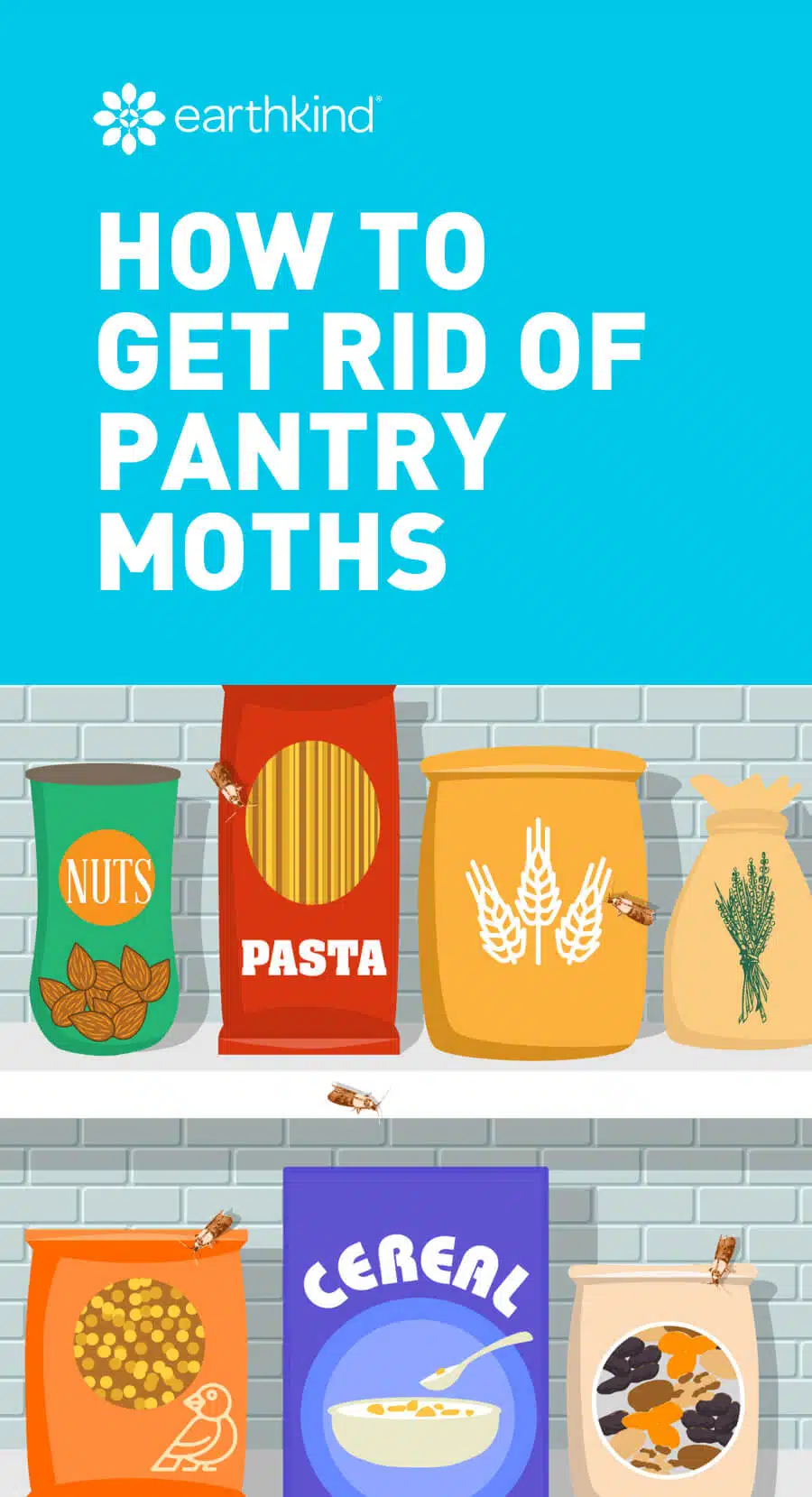Getting Rid of Pantry Moths in Your Home
By: EarthKind
Pantry moths are burdensome pantry pests. These little critters are notorious for getting into the following food products and processed goods:

Candy, nuts, birdseed, pet food, cereals and grains, flour, powdered milk, dried fruit, dried herbs, and pasta
If you’ve noticed them flying around your pantry or disappointingly discovered larvae or webbing in food items; you might have an infestation.
The larvae may have been present in the infested food you brought home from the grocery store or a moth could have come into your home and laid eggs near or inside your food containers. Regardless of how your infestation started, getting rid of it as quickly as possible should be your priority.
Identifying the issue
Pantry moths are not the only pests that infest stored dry foods. A variety of beetles, weevils, mealworms, and other insects can all infest stored goods and contaminate food.
However, Indian Meal Moths are a common type of pantry pest. Other moths that could be found include the Angoumois Grain Moth, Mediterranean Flour Moth, and almond moth.
For identification purposes, it’s important to understand the pantry moth life cycle. They start as eggs, transform into worm-like larvae, and eventually reach maturity as the winged insects that fly around. Getting rid of the adults might make you feel better, but it’s actually the larvae that are responsible for damaging food items.
One adult female moth can lay up to 400 eggs per mating cycle which can hatch in as little as 48 hours! Once hatched, the larvae look like small worms. They feast on items in your pantry and leave behind silk webs. Look for these clues when trying to identify the problem.
How to Get Rid of Pantry Moths
Once you’ve determined it’s a moth problem you are dealing with, consider the following steps to help get rid of them. Many of these tips will help with any type of infestation but check with a pest prevention expert if the problem persists.
1. Dispose of all of your dried goods
While no one feels good about wasting food, in this case, it’s unavoidable. If you’ve noticed small worms that resemble moth larvae, it’s time to get rid of anything they could feed on. The larvae can chew through plastic bags and thin cardboard. This likely puts most goods in your pantry at risk.
Dispose of your at-risk food by removing it from its packaging, placing it in a compostable bag, tie it up, and immediately remove it from your home. To ensure that these pests do not return, place the tied-up bag in your compost bin at least 30 feet from your home. Place any packaging from these food items in a bag, tie it up, and immediately remove them from your home.
Tip: Prevent future infestations by storing dried goods like flour, oats, and grains in airtight containers.
2. Thoroughly clean up your pantry
While moths might be easy to spot, their larvae are not. These teeny tiny worms can wedge themselves under the rims of cans, in tiny corners, and any other small crevice. Empty out everything that’s uncontaminated from your pantry. Consider freezing those items, if possible, just to be sure they aren’t contaminated.
Once emptied, wash all of your shelves and drawers. If you have a door to your pantry, wipe the knobs and hinges with soap and hot water.
Vacuum and mop the space meticulously. Throw away your vacuum bag. If your vacuum is bagless, wash out the dust compartment. This will prevent larvae from making a home in your vacuum.
Tip: Scrub all of your canned goods with hot soapy water, or–depending on how bad the infestation is–empty canned goods and recycle them. Missing just one egg or worm could be the difference between having another infestation or not.
3. Dispose of all paper materials
Paper-eating bugs love starches, sugars, and carbohydrates. Paper is actually a starchy food source for moth larvae. Paper bags, cookbooks, magazines, tea bags, and anything else with paper in it can contain larvae worms.
Dispose of ALL the paper in your pantry to ensure no eggs or larvae are accidentally left behind. Before throwing out important papers or books, take photos of any information you want to keep.
Tip: You can try to save valued books or other papers by placing them in the freezer for 4-7 days. This will kill the larvae and eggs. Unfortunately putting paper in the freezer can sometimes damage it.
4. Use a botanical repellent
Get rid of any moths you may have missed and repel others from coming back by using Stay Away® Moths. This plant-based repellent continuously protects your pantry for 30 days without the use of harmful chemicals.
These pouches work naturally by emitting a scent that is pleasant to people but offensive to moths. For continuous 30-day protection, simply place one Stay Away Moths pouch per 25 sq ft in areas where they’re present. Replace after 30 days.
Tip: Use the bio-based Pouch Pod to prolong the use of the pouch by 3X. This stylish protective pod is not only discreet, it slowly and consistently releases the pouch’s oils ensuring it lasts longer.
Keep your home pest free with simple, effective solutions. Subscribe and save!
Further Prevention
After getting rid of a pantry moth infestation, you’ll never want to deal with a mess like that again! The following tips help prevent future infestations:
- These pests cannot survive extreme cold, so if possible, you can place items in the freezer for one week to ensure no surviving larvae remain.
- Inspect new food and items before bringing them into your home.
- Remove new food items from their original food packaging and store them in glass, metal, or plastic containers. Make sure these sealed containers are airtight!
- Use a natural scent to repel them by placing bay leaves on pantry shelves, or setting out a pouch of Stay Away®.
Lastly, please remember to never use toxic mothballs, especially around food. Mothballs, which may look like candy or treats to small children and pets, contain harmful chemicals that can result in serious illness and even death. Always check the safety of the ingredients on labels or ask for Safety Data Sheets when purchasing pest control products.









 day
day